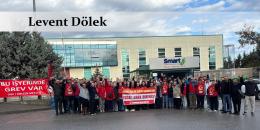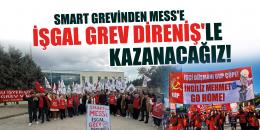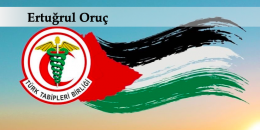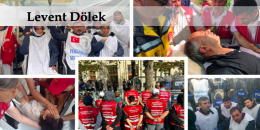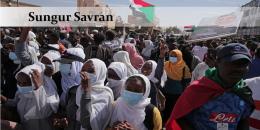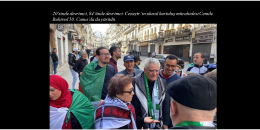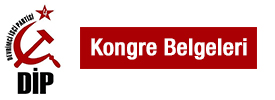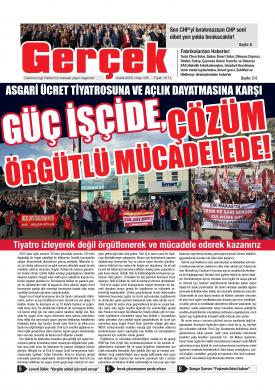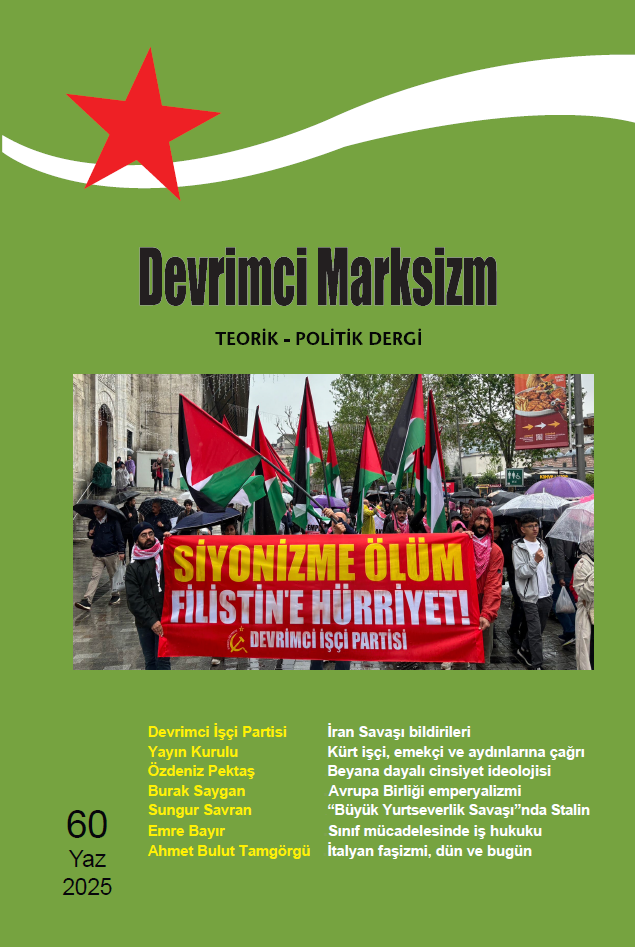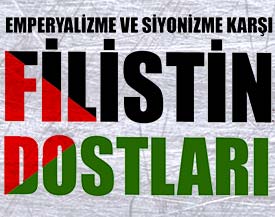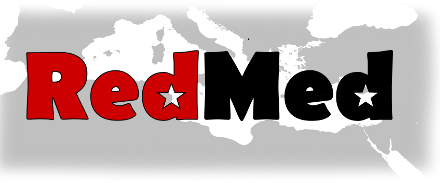The Sudanese revolution

The popular insurgency in Sudan has now completed a full two months. The people of Sudan have been demonstrating on the streets of the country since 19 December 2018 to demand from the despot Omar al Bashir “tasqut bas” (“Just fall” or “Fall, that is all” as sometimes translated). More importantly, the demonstrations have turned from a popular rebellion that protested economic catastrophe and political brutality into a full-blown revolution that threatens the very foundations of the despotic Islamist dictatorship of al Bashir, who came to power three decades ago, in 1989. Not only has there been a gradual gathering of forces on the part of the movement that is fighting to bring down al Bashir, but growing fissures in the ruling bloc are showing that the regime is trying to preserve itself through dire measures that may even sacrifice the dictator al Bashir himself in order safeguard the interests of the socio-economic bloc that has been benefiting from the regime.
Salah Abdallah Gosh, head of the powerful National Intelligence and Security Service (NISS) and redoubtable rival of Omar al Bashir from within the regime, declared, on 22 February, that al Bashir was to step down and his project of constitutional amendment to make it possible for him to run a third time for president of the country would be dropped. That very evening, Omar al Bashir held a meeting with the dignitaries of his regime to announce that he was not leaving and that he was both establishing a state of emergency and dismissing federal government and replacing state governors with military caretakers. This is no doubt an auto-golpe, as the Latin American political tradition characterizes the phenomenon of conducting a coup against one’s own regime, and shows that a new phase has been entered in the momentous events unfolding in Sudan. This is no longer a popular rebellion, which, even when it is of earth shaking dimensions, is incapable, for objective and/or subjective reasons, of making a claim on political and, a fortiori, social power, but a revolution, a forceful quest for power by definition.
The background
The imperialist nature of the world order even replicates itself in the ranks of the downtrodden and the insurgent. As opposed to the French gilet jaunes, to which we attribute great importance as a movement (see our overall assessment here: http://redmed.org/article/yellow-vests-la-republique-en-marche-arriere), has been so much at the centre of attention worldwide, not even a fraction of the attention devoted to that movement was turned on the events in Sudan. It is true that the French events began in November, whereas the Sudanese uprising came on the scene a full month later, on 19 December. But since then, as opposed to the weekly actes of the French demonstrators, Sudanese people have come out on the streets persistently day in and day out and, although French police have also been provocatively aggressive in their response to the demonstrations, the Sudanese regime, nothing short of a murderous strong man dictatorship, where all democratic forms are pretty much a disguise, constantly shot at demonstrators with live ammunition, has killed so far according to independent estimates some 60 people in two months, and has imprisoned in what are labelled “ghost houses” some two thousand fighters. In addition to the regular police forces, the military and the intelligence apparatus, al Bashir wields a praetorian guard, paramilitary militia called the Rapid Support Forces, notorious for its savage methods. It is in such a country that the Sudanese people have been waging an unending fight against the despot for over two months now.
The events were triggered in December by the three-fold rise in the price of bread, along with a similar hike in fuel, as a result of the removal of subsidies on these two items urged by the IMF. Sudan has been at the throes of economic hardship ever since the secession of South Sudan in 2011 because this reduced the oil revenues of the country by three fourths. Add to this the rising impact of the world depression and the country has fallen into a serious crisis in the recent period. The government of Omar al Bashir was at loggerheads with the imperialist countries until 2017, even being incriminated by the International Criminal Court for alleged genocide in Darfur (where the population is, in its majority, black, as opposed to the Arabized population of the rest of the country), but things have turned around since then. That is why the IMF is now part of the scene and also why both the US and the EU, as well as China, have turned a blind eye to the desperate struggle of the masses to get rid of their three-decade dictator and the brutal repression that they are being subjected to.
The events started on 19 December in Atbara in the north, the city that was always at the forefront of social unrest and working class organising since colonial times, where the traditionally strong Communist Party of Sudan has been influential, a city nicknamed the city of “al hadid wa al nar” (“steel and fire”) for these reasons. They spread like wildfire to 15 other cities, including Khartoum, the capital city, and Port Sudan, an important port city on the Red Sea, in a matter of days. The government immediately shut down universities, high schools and dormitories, as youth were an integral part of the demonstrations. On the 25th, the crowds marched to the headquarters of the National Congress Party, the party in power, to demand the ouster of al Bashir. On the 9th January, they would march, this time, on the parliament in Omdurman (the name of a town that is really one of three towns that form the city of Khartoum). Even at this stage, the major slogan of the Arab revolution of 2011-2013, “The people want the fall of the regime!”, had been widely adopted, to which a more succinct homebred slogan was added “Tasqut bas”, sometimes translated as “Fall, that is all!”
From the beginning, the leadership was most visibly in the hands of the Sudanese Professional Associations, involving the organisations of the liberal professions, medical doctors, lawyers, engineers, pharmacists, teachers etc., an amalgam of modern petty-bourgeois layers and the upper, educated crust of the proletariat. The progressive activism of these layers has been quite common in the Muslim-dominated countries in the modern era and at least in the case of the Jordan uprising of mid-2018 a similar kind of organisation led the struggle. However, all indicators show that what is occurring is not confined to a kind of middle class “democratic” protest. Next to the professional associations, trade unions are also visible in the struggle and the neighbourhoods populated by the wide layers of the urban poor, mostly disorganised proletarians in addition to some déclassé layers, are very active as well. Youth, as has been said, is a powerful element. And the presence of women, both among the student demonstrators and the crowds of professionals, is notable. It should perhaps be added that both professional organisations and trade unions were proscribed during the rise to power of Omar al Bashir, together with the Islamist Front of Hasan al Turabi, in the late 1980s and early 1990s, so that these organisations are really de facto networks rather than consolidated structures with a basis in Sudanese law. One other characteristic of the movement is the movement’s reach across the different ethnic, religious and tribal groups, trying to draw all the different sectors inside. This is one of the major strengths of the movement in a country where internecine strife among such groups has lately been the rule rather than the exception, with the North-South and Darfur conflicts standing out in their sheer violence and bloodshed, but other wars and armed conflicts also present. Whether the movement will succeed to preserve its unity throughout is of course to be seen, but one thing that is certain is that this is no ethnic or tribal strife. It is class struggle, with various classes that obviously have different interests fighting against the corrupt regime of a rich and restricted oligarchy.
From popular rebellion into a revolution
The perseverance of the masses has proved that the insurgency is not the product of a passing mood, but is the expression of a pent-up rage within the recesses of society that have now erupted into the open. Many uprisings in the period of the Third Great Depression, i.e. the post-Lehman Brothers period, have remained restricted to popular rebellions or people’s revolts, without a claim by the large masses on political power. The uprisings in question are not objectively sufficiently strong, in terms of the class forces they represent and/or and in terms of their organising, i.e. do not have the instruments through which to take power, or subjectively unprepared to march towards power, i.e. their consciousness is limited to a state of protestation and discrete demands rather than yearning to become the master of their own fate. The objective and subjective sides are, of course, not isolated from each other and most obviously intermingle in the case of the political forces, in particular political parties, that speak for the classes in action. However, a popular rebellion may turn almost imperceptibly into a political or even social revolution through a process of ebullition and accumulation of forces by the masses revolting against the socio-economic and political order. The action itself may engender the political instruments through which power may be taken. An obvious candidate is the mass movement throwing up organs of power such as councils or soviets, which would immediately turn a popular rebellion into a revolution. Another transitional trajectory may be the increasing hegemonic domination of the mass movement by class-based action, for instance strikes and workplace occupations by the working class leading to a clear class confrontation between the major classes of capitalist society. Yet another route may be the fissures within the ruling bloc becoming so strong as to differentiate certain forces from within the establishment that side with the revolt itself, which then put an end to the regime and open up the possibility of the construction of another.
There are clear signs that in the case of Sudan, it may be said with some caution due to our distance from the country and our limited sources of information gathering, that such a transition has already taken place. Sudan, it seems to us, is now in midst of a revolution. There are at least four developments that serve as the basis of this characterisation.
First, the sheer breadth and depth of the movement and its perseverance pushes us to abandon talk of a popular rebellion and move on to a recognition that these masses are full of revolutionary rage and zeal. The unrest has now taken hold of states (or provinces) as diverse as Khartoum and Darfur, which, only a decade ago, were involved in a bloody war that has even been called “genocide”. It extends from the borders of sub-Saharan Africa in the west to the Red Sea in the east. It brings together the different labouring classes of society, modernised and conservative, with lifestyles and standards ranging from the well-to-do to the miserable. It is far from being a “middle-class” protest (a term so abused that we feel the need to put it in inverted commas even as we use it in the only meaningful sense), such as the so-called “Green Revolution” in Iran in 2009. It has become audacious, as all revolutions are. It has now entered the mosque during the Friday prayers, with slogans chanted inside some mosques after the prayer or even the waging of a fight over the soul of the Friday hutba(sermon) on two accounts. In one incident, the famous Salafi Imam Abu Hay Yousif was stopped in the middle of his Friday sermon because he was clearly taking the side of the government and refusing to support the uprising. In Atbara, a religious waqf (foundation) was ransacked because of its reactionary attitude towards the mass movement.
Secondly, the struggle has more and more taken the form of proletarian methods of struggle in the name of class demands. Within the last ten days or so, workers of both the private and the public sector have not only staged wildcat strikes, but also occasionally occupied their workplaces. In particular, the workers of Port Sudan, where the ground is being prepared for privatisation through sale to a foreign company, have waged a powerful strike. Workers in several telecoms companies have also engaged in work stoppages. This is no longer a citizens’ movement, nor even one of cross-class multitudes under the leadership of the organisations of the modern wing of the petty-bourgeoisie and the proletariat. It is becoming the arena for the self-activity and self-organising of the most revolutionary class of modern society, the proletariat.
Thirdly, diverse programmes are being laid out for the course of both the revolution and of counter-revolution by different political forces, supported obviously by different classes and strata. The main scenario, the dominant one within the leadership of the Sudanese Professional Associations as far as we are able to understand, is the ouster of Omar al Bashir along with his National Congress Party, a “technocratic” transitional government taking over for a period of four years in order to prepare the country for a multi-party parliamentary regime. An alternative route that is defended from within the mass movement, we understand, is the immediate transition of the country to free and fair elections. We are not aware of the demand for a “constituent assembly”, but this seems to be the approximate meaning of this programme as opposed to the “technocratic transitional government” model. The immediate transition to elections seem to be more consonant with the interests of the working class and a prospective process of permanent revolution. It is noteworthy that “communist” parties from many countries around the world have signed a joint declaration supporting the slogan of a “national democratic revolution”, the clear implication being that the Communist Party of Sudan is ready to side with the more “democratic” wings of the bourgeoisie and the petty bourgeoisie and will arrest the further development of the revolution should workers and peasants show signs of marching even further.
The programme of the counter-revolution ranges from al Bashir’s own coup through an “orderly transition” all the way to overtly reactionary methods of salvaging the regime, ending, at the pessimistic extreme, with an apocalyptic scenario. Let us briefly discuss these one by one. The declaration of the dissolution of all the institutions of the country and the transfer of their powers to al Bashir himself and the military is of course a clear attempt at counter-revolution in the most crass manner. However, it must be emphasized that at the same time this shows that the power base of al Bashir has narrowed down very seriously and that he cannot trust even the handpicked ministers and state governors of his own party.
The “orderly transition” scenario, which really boils down to an adaptation of what is traditionally called a “palace coup” to the conditions of republican polities, was the basic rule applied in the first round of the Arab revolution by imperialism and its major allies in Arab countries, the military. It was most successfully implemented in the case of Egypt and with the most catastrophic medium-term effects in the case of Yemen. In the case of the Sudanese revolution, this would mean the ejection of al Bashir by the military and his replacement by another strong man pursuing the same orientation, albeit of a lesser status.
Distinct from this probably, and more reactionary in its nature, would be a coup staged by Salah Abdallah Gosh, the director of the National Intelligence and Security Services (NISS). Gosh is a close ally of the US intelligence apparatus and has cooperated in the so-called “counter-terrorism investigations” of the latter. He is known to have plotted a coup against al Bashir earlier, but has somehow survived in office. The US connection is not the only reason why a Gosh coup would be more reactionary than a “palace coup”. The latter may in the end result in a complete transition to a parliamentary system should the momentum of the revolution persist. Thus it is not entirely counter-revolutionary, but postpones the reckoning to a later date under different circumstances, circumstances that the regime would hope would be better for itself. The Gosh coup would, if successfully consolidated, probably arrest the further development of the revolution, both because its leader dominates the most formidable state apparatus in Sudan and also because he has been a powerful figure in the country’s political setup, second probably only to al Bashir.
The apocalyptic scenario is being used by the establishment, including by al Bashir himself, as a scarecrow against the mass movement. This is the Libya-Syria scenario. It is said that should the “chaos” (read: the revolution) continue for long, Sudan would fall into the same trap as the above countries and that (with special reference to the Syrian situation) the demonstrators or strikers, together with the rest of the Sudanese people, would turn into a “nation of refugees”. This is no doubt possible. It should be remembered that Syria experienced, in the heat of the Arab revolution, a popular uprising for six months from 15 March to September 2011, and when it became clear that neither the government nor the insurgency proved capable of beating the other side, imperialism and regional powers (Saudi Arabia, Qatar, and Turkey) stepped in to foment a civil war, which later turned into an international set of proxy wars. Sudan having multiple bombs in its lap in the form of ethnic, religious, regional, and tribal strife, it is not inconceivable that the country should break down into a multitude of warlord zones as in the case of Syria until recently and Libya still.
Regional and international fallout
The revolution in Sudan is of momentous importance, going beyond all the significance the country holds with respect to its geostrategic position as an important actor on the Red Sea, a neighbour of Egypt, and a country of passage between the Arab world and sub-Saharan Africa. From this vantage point, it should be pointed out that al Bashir is trying to curry the favour of all powerful actors that will have an impact on the outcome of the revolution. Since 2017 it has been on good terms with the US and EU, although the latter may prefer Gosh or another strong man because al Bashir no longer promises a stable regime for imperialist interests. As for the two reactionary camps that have been born as a result of the complex process of the Arab revolution, the camp around Saudi Arabia, first and foremost including the United Arab Emirates and Egypt, and the camp led by Erdoğan of Turkey, with his strong ally of Qatar, al Bashir seems to be trying a balancing act, remaining equidistant and searching for help from both. He visited Egypt in the heat of the insurgency and has sent troops to Yemen to please Saudi Arabia, but Sudan under his regime has also had extremely close relations with Erdoğan’s Turkey, both economically and diplomatically.
However, the real importance of the Sudanese revolution lies in this that, if successful, even partially, it promises (or threatens, whichever way you look at it), to arouse the spirit of revolutionary zeal in the Arab world once again within the space of a single decade! It should be remembered that the Arab world has already started to stretch its arms and legs. In the course of 2018, at least three Arab countries, Tunisia, Iraq, and Jordan, to which should be added one of the non-Arab giants of the Middle East, Iran, have seen their masses rise in anger over class economic questions, to such a level of intensity that in Iran and Iraq events have been continuing for months, even a year in the former case, and in Jordan a government was brought down last summer under the pressure of the revolt of the masses. Tunisia, where a successful general strike was organised by the confederation UGTT recently, is really a country where revolution has not stopped entirely since 2010-11.
A victory, even if partial, of the masses in Sudan will, in all probability, provoke similar urges in other Arab countries. It would first have an impact on those countries already in ebullition, the ones we have already mentioned. But the ultimate moment of truth will come when the northern neighbour of Sudan, the giant of the Arab world, Egypt undergoes the same kind of effect. So the Arab revolution is far from dead, if such is the case.
From the “year of inflection” to the year of living hopefully
In twin articles published on this web site on the last day of 2018 and the first day of 2019, we first took up the movement of the “Yellow Vests” in France and then moved on, in the second instalment, to a more general assessment of the world situation in terms of popular movements around the world (See http://redmed.org/article/yellow-vests-la-republique-en-marche-arriereand http://redmed.org/article/2018-year-resurgence-third-wave-world-revolution).We called 2018 “the year of inflection”. We intended by this to point to a resurgence of popular unrest around the world after, first, the revolutionary wave of 2011-2013 in the Arab world first foremost, but also in countries as wide-ranging as Spain, Greece, the United States, Turkey and Brazil, as well as many Balkan countries, and, secondly, the period of lull between 2014-2017. 2018 saw 12 insurgencies in 12 months (Iran, Tunisia, Romania, Slovakia, Armenia, Nicaragua, Jordan, Iraq, Haiti, France, Sudan and Hungary). This was the inflection. We saluted this as the beginning of a new wave of mass struggles.
Een in the space of two months, 2019 has brought other countries such as Zimbabwe and Serbia into the fray. But more importantly, two of the popular revolts of last year, Sudan and possibly distant Haiti, are now turning into revolutions. This is a qualitative leap. It is no longer an inflection, but a thunderous irruption of revolution on the world stage.
May the Sudanese revolution march from success to victory and infuse revolutionary zeal and audacity in the peoples of the rest of the world, starting from its Arab brothers and sisters!

